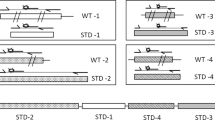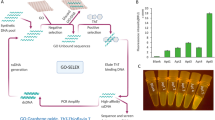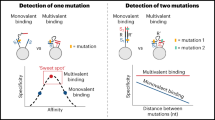Abstract
This protocol describes a simple, convenient and sensitive single-nucleotide polymorphism (SNP) genotyping method using an optically amplifying cationic conjugated polymer and single base primer extension reaction. The fluorescence resonance energy transfer (FRET) efficiency between the conjugated polymer (PFP, poly{(1,4-phenylene)-2,7-[9,9-bis(6'-N,N,N-trimethyl ammonium)-hexyl fluorene] dibromide}) and a fluorescein-labeled dNTP (dNTP-Fl) is correlated to the incorporation of the dNTP-Fl into an allele-specific primer; incorporation occurs by a single base extension reaction when the target DNA and the primer are complementary at the SNP site. By triggering the FRET from PFP to fluorescein and measuring the change in fluorescence intensity of samples, the SNP genotypes can be discriminated. In comparison with other SNP genotyping methods, this protocol simplifies procedures and improves sensitivity by eliminating the need for primer labeling, cumbersome workups, chemical/enzymatic coupling reactions and sophisticated instruments. The assay takes about 2 h for PCR amplification followed by 5.5–7.5 h to obtain the genotypes.
This is a preview of subscription content, access via your institution
Access options
Subscribe to this journal
Receive 12 print issues and online access
$259.00 per year
only $21.58 per issue
Buy this article
- Purchase on Springer Link
- Instant access to full article PDF
Prices may be subject to local taxes which are calculated during checkout




Similar content being viewed by others
References
The International HapMap Consortium. A haplotype map of the human genome. Nature 437, 1299–1320 (2005).
The International HapMap Consortium. A second generation human haplotype map of over 3.1 million SNPs. Nature 449, 851–861 (2007).
Yang, Q., Kathiresan, S., Lin, J.P., Tofler, G.H. & O'Donnell, C.J. Genome-wide association and linkage analyses of hemostatic factors and hematological phenotypes in the Framingham Heart Study. BMC Med. Genet. 8 (Suppl 1): S12 (2007).
Scuteri, A. et al. Genome-wide association scan shows genetic variants in the FTO gene are associated with obesity-related traits. PLoS Genet. 3, e115 (2007).
Shabo, A. Integrating genomics into clinical practice: standards and regulatory challenges. Curr. Opin. Mol. Ther. 10, 267–272 (2008).
Kim, S. & Misra, A. SNP genotyping: technologies and biomedical applications. Annu. Rev. Biomed. Eng. 9, 289–320 (2007).
Kirk, B.W., Feinsod, M., Favis, R., Kliman, R.M. & Barany, F. Single nucleotide polymorphism seeking long-term association with complex disease. Nucleic Acids Res. 30, 3295–3311 (2002).
Cotton, R.G.H., Edkins, E. & Forrest, S. Mutation Detection. Oxford University Press, New York, USA, 1998.
Ranade, K. et al. High-throughput genotyping with single nucleotide polymorphisms. Genome Res. 11, 1262–1268 (2001).
Rao, K.V.N. et al. Genotyping single nucleotide polymorphisms directly from genomic DNA by invasive cleavage reaction on microspheres. Nucleic Acids Res. 31, e66 (2003).
Olivier, M. The Invader assay for SNP genotyping. Mutation Research 573, 103–110 (2005).
Li, J. & Makrigiorgos, G.M. Anti-primer quenching-based real-time PCR for simplex or multiplex DNA quantification and single nucleotide polymorphism genotyping,. Nat. Protoc. 2, 50–58 (2007).
Kwok, P.Y. SNP genotyping with fluorescence polarization detection. Hum. Mutat. 19, 315–323 (2002).
Royo, J.L., Hidalgo, M. & Ruiz, A. Pyrosequencing protocol using a universal biotinylated primer for mutation detection and SNP genotyping. Nat. Protoc. 2, 1734–1739 (2007).
Lavebratt, C. & Sengul, S. Single nucleotide polymorphism (SNP) allele frequency estimation in DNA pools using pyrosequencing. Nat. Protoc. 1, 2573–2582 (2006).
Tost, J. & Gut, I.G. Genotyping single nucleotide polymorphisms by mass spectrometry. Mass Spectro. Rev. 21, 388–418 (2002).
Kim, Y., Sohn, D. & Tan, W.H. Molecular beacons in biomedical detection and clinical diagnosis. Int. J. Clin. Exp. Pathol. 1, 105–116 (2008).
Yesilkaya, H. et al. Evaluation of molecular-beacon, TaqMan, and fluorescence resonance energy transfer probes for detection of antibiotic resistance-conferring single nucleotide polymorphisms in mixed Mycobacterium tuberculosis DNA extracts,. J. Clin. Microbiol. 44, 3826–3829 (2006).
Gaylord, B.S., Massie, M.R., Feinstein, S.C. & Bazan, G.C. SNP detection using peptide nucleic acid probes and conjugated polymers: applications in neurodegenerative disease identification. Proc. Natl. Acad. Sci. USA 102, 34–39 (2005).
Thomas, S.W. III, Joly, G.D. & Swager, T.M. Chemical sensors based on amplifying fluorescent conjugated polymers. Chem. Rev. 107, 1339–1386 (2007).
Liu, B. & Bazan, G.C. Homogeneous fluorescence-based DNA detection with water-soluble conjugated polymers. Chem. Mater. 16, 4467–4476 (2004).
He, F. et al. Quadruplex-to-duplex transition of G-rich oligonucleotides probed by cationic water-soluble conjugated polyelectrolytes. J. Am. Chem. Soc. 128, 6764–6765 (2006).
Feng, F. et al. Cationic conjugated polymer/DNA complexes for amplified fluorescence assays of nucleases and methyltransferases. Adv. Mater. 19, 3490–3495 (2007).
Xu, H. et al. Magnetically assisted DNA assays: high selectivity using conjugated polymers for amplified fluorescent transduction. Nucleic Acids Res. 33, e83 (2005).
Duan, X.R., Li, Z.P., He, F. & Wang, S. A sensitive and homogeneous SNP detection using cationic conjugated polymers. J. Am. Chem. Soc. 129, 4154–4155 (2007).
Duan, X., Wang, S. & Li, Z. Conjugated polyelectrolyte-DNA complexes for multi-color and one-tube SNP genotyping assays. Chem. Commun., 1302–1304 (2008).
Duan, X., Liu, L. & Wang, S. Homogeneous and one-step fluorescent allele-specific PCR for SNP genotyping assays using conjugated polyelectrolytes. Biosen. Bioelectron. 24, 2095–2099 (2009).
Xiao, M. et al. Role of excess inorganic pyrophosphate in primer-extension genotyping assays. Genome Res. 14, 1749–1755 (2004).
Liu, B., Wang, S., Bazan, G.C. & Mikhailovsky, A. Shape-adaptable water-soluble conjugated polymers. J. Am. Chem. Soc. 125, 13306–13307 (2003).
Liu, B. & Bazan, G.C. Synthesis of cationic conjugated polymers for use in label-free DNA microarrays. Nat. Protoc. 1, 1698–1702 (2006).
Li, Z.P., Tsunoda, H., Okano, K., Nagai, K. & Kambara, H. Microchip electrophoresis of tagged probes incorporated with one-colored ddNTP for analyzing single-nucleotide polymorphisms. Anal. Chem. 75, 3345–3351 (2003).
Deng, G.H. et al. Association of estrogen receptor alpha polymorphisms with susceptibility to chronic hepatitis B virus infection. Hepatology 40, 318–326 (2004).
Acknowledgements
We thank all the individuals tested. This work was supported in part by grants from the “100 Talents” program of the Chinese Academy of Sciences, the National Natural Science Foundation of China (nos. 20725308, 30621063 and 30872929), the National High-Tech R&D Program of China (nos. 2006AA02Z130 and 2006AA02A412), the Major Research Plan of China (no. 2006CB932102) and the Key Project for the Infectious Diseases of China (no. 2008ZX10002-016).
Author information
Authors and Affiliations
Corresponding authors
Supplementary information
Supplementary Data 1
The sequencing results of 26 samples at SNP site rs1800469. (PDF 437 kb)
Supplementary Data 2
The sequencing results of 50 samples at SNP site rs2241715. (PDF 912 kb)
Supplementary Fig. 1
Genotyping results for SNP site (rs1800469: C<T) using CP–based SNP genotyping method with sample number as symbol. FRET ratio of PFP to fluorescein (I530nm/I425nm) using C allele primer as X axis, and that using T allele primer as Y axis. No-template control (NTC) is used as a blank. (PDF 58 kb)
Supplementary Fig. 2
Genotyping results for SNP site (rs2241715:G<T) using CP–based SNP genotyping method with sample number as symbol. FRET ratio of PFP to fluorescein (I530nm/I425nm) using G allele primer as X axis, and that using T allele primer as Y axis. No-template control (NTC) is used as a blank. (PDF 60 kb)
Supplementary Table 1
The purpose and sequences of primers for PCR of SNPs rs1800469 and rs2241715. (PDF 47 kb)
Supplementary Table 2
Purpose and sequences of primers for single base extension reaction of SNPs rs1800469 and rs2241715. (PDF 46 kb)
Rights and permissions
About this article
Cite this article
Duan, X., Yue, W., Liu, L. et al. Single-nucleotide polymorphism (SNP) genotyping using cationic conjugated polymers in homogeneous solution. Nat Protoc 4, 984–991 (2009). https://doi.org/10.1038/nprot.2009.70
Published:
Issue Date:
DOI: https://doi.org/10.1038/nprot.2009.70
This article is cited by
-
Fluorescence Visual Detection of Herbal Product Substitutions at Terminal Herbal Markets by CCP-based FRET technique
Scientific Reports (2016)
-
Construction of a high density SNP linkage map of kelp (Saccharina japonica) by sequencing Taq I site associated DNA and mapping of a sex determining locus
BMC Genomics (2015)
-
Convenient, Sensitive and High-Throughput Method for Screening Botanic Origin
Scientific Reports (2014)
-
Multiplex detection of KRAS and BRAF mutations using cationic conjugated polymers
Chinese Science Bulletin (2013)
-
Integration of rolling circle amplification and cationic conjugated polymer for the homogeneous detection of single nucleotide polymorphisms
Chinese Science Bulletin (2011)
Comments
By submitting a comment you agree to abide by our Terms and Community Guidelines. If you find something abusive or that does not comply with our terms or guidelines please flag it as inappropriate.



